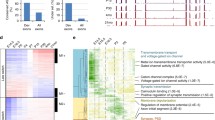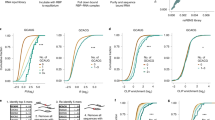Abstract
The closely related and functionally antagonistic POU family transcription factors Brn-3a and Brn-3b are encoded by two distinct genes that are expressed primarily in neuronal cells. In addition, however, the primary transcript of each of these genes is alternatively spliced to produce two distinct mRNAs encoding long and short isoforms that differ at theN-terminus of the protein. We show that this process is regulated so that different proportions of the mRNAs encoding the long and short forms of either Brn-3a or Brn-3b are produced in different rat tissues. Similarly, the ratio of each of these forms can be modulated by specific stimuli in both a neuronal cell line and primary neurons. The significance of these effects is discussed in relation to the functional differences between the two forms of each factor.
Similar content being viewed by others
References
Budhram-Mahadeo V., Theil T., Morris P. J., Lillycrop K. A., Möröy T., and Latchman D. S. (1994) The DNA target site for the Brn-3 POU family transcription factors can confer responsiveness to cyclic AMP and removal of serum in neuronal cells.Nucleic Acids Res. 22, 3092–3098.
Budhram-Mahadeo V., Morris P. J., Lakin N. D., Theil T., Ching G. Y., Lillycrop K. A., Möröy T., Liem R. K. H., and Latchman D. S. (1995a) Activation of the α-internexin promoter by the Brn-3a transcription factor is dependent on the N-terminal region of the protein.J. Biol. Chem. 270, 2853–2858.
Budhram-Mahadeo V., Lillycrop K. A., and Latchman D. S. (1995b) The levels of the antagonistic transcription factors Brn-3a and Brn-3b in neuronal cells are regulated in opposite directions by serum growth factors.Neurosci. Lett. 185, 48–51.
Cavicchioli L., Flanigan T. P., Dickson J. G., Vantini G., Daltoso R., Fusco M., Malsh F. S., and Leon A. (1995) Choline acetyl transferase messenger RNA expression in developing and adult rat brain: regulation by nerve growth factor.Mol. Brain Res. 9, 319–325.
Chirgwin J. M., Przybyla A. E., MacDonald R. J., and Rutter W. J. (1979) Isolation of biologically active ribonucleic acid from sources enriched in ribonuclease.Biochemistry 18, 5294–5299.
Danielson P. A., Forss-Petter S., Brow M. A., Calavetta L., Douglass J., Milner R. J., and Sutcliffe J. G. (1988) p1B15: a cDNA clone of the rat mRNA encoding cyclophilin.DNA 7, 261–267.
Gerrero M. R., McEvilly R. J., Turner E., Lin C. R., O’Connell S., Jenne K. J., Hobbs M. V., and Rosenfeld M. G. (1993) Brn-3.0: a POU domain protein expressed in the sensory, immune and endocrine systems that functions on elements distinct from known octamer motifs.Proc. Natl. Acad. Sci. USA 90, 10,841–10,845.
He X., Treacy M. N., Simmons D. M., Ingraham H. A., Swanson L. S., and Rosenfeld M. G. (1989) Expression of a large family of POU-domain regulatory genes in mammalian brain development.Nature 340, 35–42.
Kawasaki E. S. (1990) Amplification of RNA, inPCR Protocols (Innis M. A., Gelfard D. H., Sninsky J. J., and White T. J., eds.), Academic, San Diego, CA, pp. 21–27.
Kendall G., Ensor E., Brar-Rai A., Winter J., and Latchman D. S. (1994) Nerve growth factor induces expression of immediate-early genes NGFI-A (Egr-1) and NGFI-B (nur77) in adult dorsal root ganglion neurons.Brain Res. 25, 73–79.
Kendall G., Brar-Rai A., Ensor E., Winter J., Wood J. N., and Latchman D. S. (1995) Nerve growth factor induces the Oct-2 transcription factor with the kinetics of an immediate-early gene.J. Neur. Res. 40, 169–176.
Latchman D. S. (1991)Eukaryotic Transcription Factors, Academic, London.
Latchman D. S. (1995)Gene Regulation: A Eukaryotic Perspective, 2nd ed. Chapman and Hall, London.
Lillycrop K. A., Budhram V. S., Lakin N. D., Terrenghi G., Wood J. N., Polak J. M., and Latchman D. S. (1992) A novel POU family transcription factor is closely related to Brn-3 but has a distinct expression pattern in neuronal cells.Nucleic Acids Res. 20, 5093–5096.
Lillycrop K. A. and Latchman D. S. (1992) Alternative splicing of the Oct-2 transcription factor is differentially regulated in B cells and neuronal cells and results in protein isoforms with opposite effects on the activity of octamer/TAATGARAT-containing promoters.J. Biol. Chem. 267, 24,960–24,966.
Liu Y.-Z., Lillycrop K. A., and Latchman D. S. (1995) Regulated splicing of the Oct-2 transcription factor RNA in neuronal cells.Neurosci. Lett. 183, 8–12.
Morris P. J., Theil T., Ring C. J. A., Lillycrop K. A., Möröy T., and Latchman D. S. (1994) The opposite and antagonistic effects of the closely related POU family transcription factors on the activity of a target promoter are dependent upon differences in the POU domain.Mol. Cell. Biol. 14, 6907–6914.
Ninkina N. N., Stevens G. E. M., Wood J. N., and Richardson W. D. (1993) A novel Brn-3 like POU transcription factor expressed in subsets of rat sensory and spinal cord neurons.Nucleic Acids Res. 21, 3175–3182.
Stoykova A. S., Steiner S., Erselius J. R., Hatzopoulos A. K., and Grass P. (1992) Mini-Oct and Oct-2c: two novel functionally diverse murine Oct-2 products are differentially expressed in the CNS.Neuron 841, 541–558.
Suburo A. M., Wheatley S. C., Horn D. A., Gibson S. J., Jahn R., Fischer-Colbrie R., Wood J. N., Latchman D. S., and Polak J. M. (1992) Intracellular redistribution of neuropeptides and secretory proteins during differentiation of neuronal cell lines.Neuroscience 46, 881–889.
Theil T., McLean-Hunter S., Zornig M., and Möröy T. (1993) Mouse Brn-3 family of POU transcription factors: a new aminoterminal domain is crucial for the oncogenic activity of Brn-3A.Nucleic Acids Res. 21, 5921–5929.
Theil T., Zechner U., Klett C., Adolph S., and Möröy T. (1994) Chromosomal localization and cDNA sequences of the murine Brn-3 family of developmental control genes.Cytogenet. Cell Genet. 66, 267–271.
Turner E. E., Jenne K. J., and Rosenfeld M. G. (1994) Brn-3.2: a Brn-3-related transcription factor with distinctive central nervous system expression and regulation by retinoic acid.Neuron 12, 205–218.
Verrijzer C. P. and van der Vliet P. C. (1993) POU domain transcription factors.Biochim. Biophys. Acta 1173, 1–21.
Wegner M., Drolet D. W., and Rosenfeld M. G. (1993) POU-domain proteins: structure and function of developmental regulators.Curr. Opin. Cell Biol. 5, 488–498.
Wheatley S. C., Suburo A. M., Horn D. A., Vincicevic V., Terenghi G., Polak J. M., and Latchman D. S. (1992) Redistribution of secretory granule components precedes that of synaptic vesicle proteins during differentiation of a neuronal cell line in serum free medium.Neuroscience 51, 575–582.
Wirth T., Priess A., Annweiler A., Zwilling S., and Oeler B. (1991) Multiple Oct-2 isoforms are generated by alternative splicing.Nucleic Acids Res. 19, 43–51.
Wood J. N., Bevan S. J., Coote P., Darn P. M., Hogan P., Latchman D. S., Morrison C., Rougon G., Theveniau M., and Wheatley S. C. (1990) Novel cell lines display the properties of nociceptive sensory neurons.Proc. Royal Soc. Lond. Ser. B 241, 187–194.
Xiang M., Zhou L., Peng Y. W., Ceddy R. L., Shows T. B., and Nathans J. (1993) Brn-3b: a POU domain gene expressed in a subset of retinal ganglion cells.Neuron 11, 689–701.
Author information
Authors and Affiliations
Rights and permissions
About this article
Cite this article
Liu, Y.Z., Dawson, S.J. & Latchman, D.S. Alternative splicing of the Brn-3a and Brn-3b transcription factor RNAs is regulated in neuronal cells. J Mol Neurosci 7, 77–85 (1996). https://doi.org/10.1007/BF02736850
Received:
Accepted:
Issue Date:
DOI: https://doi.org/10.1007/BF02736850




